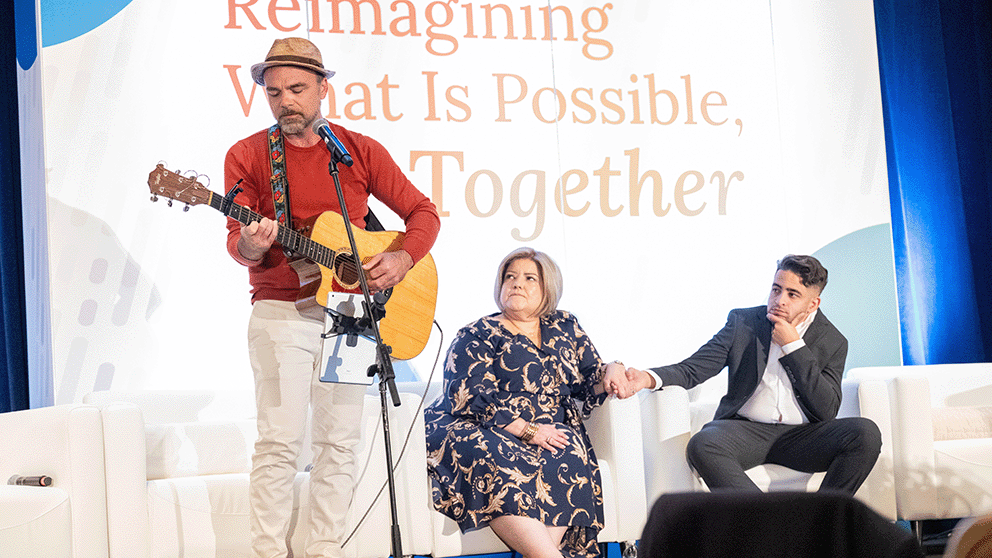 Casey McPherson (left), CEO, To Cure A Rose Foundation, CIO, Everlum Bio, sings song dedicated to his daughter, Rose, titled "Am I Enough?" to kick off Day 1 of NORD Summit. Photo provided by the National Organization for Rare Disorders.
Casey McPherson (left), CEO, To Cure A Rose Foundation, CIO, Everlum Bio, sings song dedicated to his daughter, Rose, titled "Am I Enough?" to kick off Day 1 of NORD Summit. Photo provided by the National Organization for Rare Disorders.
Washington, D.C. (October 16 – 17, 2023) – Representatives from The Jackson Laboratory (JAX) attended the 2023 National Organization for Rare Disorders Rare Diseases and Orphan Products Breakthrough Summit (NORD Summit).
The highly anticipated event hosted patient advocates, families, researchers, policymakers, pharmaceutical and biotechnology experts united in their efforts to find cures for rare diseases. An overarching theme of partnership rang throughout the two days of panel discussions covering the impact of policy changes on the rare disease community, taking effective action towards increasing diversity, equity and inclusion in data collection, the potential to cure genetic diseases through gene-editing and the power of artificial intelligence to improve patient outcomes.
Also in attendance at the NORD Summit were several of those who collaborate closely with the Rare Disease Translational Center (RDTC) at JAX, including Casey McPherson, a keynote speaker at the event. McPherson is the founder of To Cure a Rose Foundation and Everlum Bio, and through his work with both organizations, has been collaborating with the RDTC to develop a treatment for his daughter, Rose. At the NORD Summit, McPherson shared a video detailing his daughter’s journey with her rare disease, HNRNPH2, and spoke about how this drove him to establish organizations working toward a cure. He emphasized how challenging it is to do all that needs to be done to find better outcomes for children with rare diseases and encouraged the 900+ attendees to make the conscious decision to try.
“Being brave enough to take the risk is not about arriving somewhere but being strong enough to try,” says McPherson.
There was a sense of hope as representatives across the board expressed their sincere interest in supporting the rare disease community, but they also highlighted the countless hurdles patients and their caregivers face daily, especially after achieving their often long fought and hard-won diagnosis.
Heidi Bjornson-Pennell, another collaborator with the RDTC and Program Manager of the Rare As One Project with the Chan Zuckerberg Initiative, spoke on a panel detailing what makes a rare disease research-ready. The discussion highlighted one of the powerful tools groups like NORD have given patient advocates: a high-level roadmap outlining the steps to achieve their ultimate goal to get a treatment for their loved one. While some organizations admitted being in the early days of raising funding and awareness, others mentioned being a bit further down the road with a researcher or two actively searching for their condition’s genetic markers. Perhaps even a pharmaceutical company has developed their drug-of-promise. These were emphasized as huge wins, but several groups explained this is also where they are stuck.
Bjornson-Pennell, a mother to two children with a rare disease, explained that to become a truly well-equipped advocate, it is essential to fully understand the current research landscape. By delving into what natural history data has already been collected and identifying the researchers who study your disease area, patient organizations can put themselves in the position to receive the help they need. “The most important thing to make a rare disease research-ready is to build up your organization,” says Bjornson-Pennell. “Be ready to partner.”
But what happens when a rare disease becomes research-ready? Who will determine if the drug an academic researcher and industry partner have developed is effective? Where is the pre-clinical mouse model necessary to gather the right data to receive approval from the Food and Drug Administration (FDA) to begin clinical trials? Who will house existing mouse models to expand research reach? This gap was identified again and again, and happily there is a solution.
Filling a gap in the rare disease space
At JAX, the RDTC partners with over 30 rare disease patient advocacy groups, academic researchers and biotechnology companies to meet each group wherever they are in the post-diagnostic odyssey, which is truly the beginning of an even longer journey, navigating the realms of academia, industry and policy. Whether it is to develop a precise genetic mouse model or to determine the viability of a therapy for clinical trial, the RDTC is a welcoming partner to all members of the rare disease community, and acts as one centralized system for patient-focused mouse engineering, characterization and pre-clinical testing.
JAX is grateful to NORD for providing a global platform for those affected by rare disease. The RDTC is excited to continue to partner with other event speakers, including David Liu, Ph.D., Professor, Broad Institute Harvard University, Wendy Chung, M.D., Ph.D., Chief of Pediatrics, Boston Children’s Hospital and Luke Rosen, M.S., Founder, KIF1A.org.